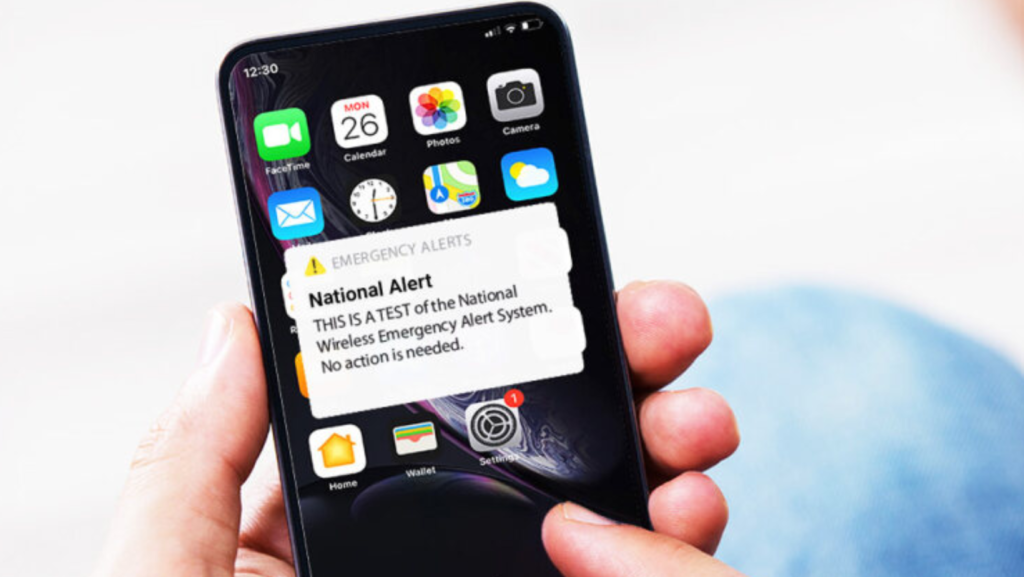
Alert: Nationwide Emergency Alert Test Scheduled Tomorrow for Phones and TVs

The Federal Emergency Management Agency (FEMA) is conducting a nationwide test of the Emergency Alert System (EAS) and Wireless Emergency Alerts (WEA) on Wednesday, Oct. 4. This test is an important step in ensuring that the public is prepared and informed about emergency alerts.
Key Takeaways:
- The nationwide emergency alert test will take place on Wednesday, Oct. 4.
- The test consists of two parts: the WEA portion for cell phones and the EAS portion for radios and televisions.
- This is the third nationwide test of WEA, but the second to include all cellular devices.
- The message on cell phones will read, “THIS IS A TEST of the National Wireless Emergency Alert System. No action is needed.”
- The EAS test will interrupt regular TV and radio programming and will state, “This is a nationwide test of the Emergency Alert System, issued by FEMA, covering the United States from 14:20 to 14:50 hours ET. This is only a test. No action is required by the public.”

What is the Emergency Alert Test?
The Emergency Alert Test is a nationwide drill conducted by FEMA to test the effectiveness of the Emergency Alert System (EAS) and Wireless Emergency Alerts (WEA) in reaching the public during emergencies. This test allows authorities to assess the functionality and readiness of these systems, ensuring that vital information can be quickly and accurately disseminated to the public in times of crisis. By conducting regular tests, FEMA can identify any potential issues and make necessary improvements to enhance emergency communication capabilities.
During the Emergency Alert Test, two components are evaluated: the WEA portion and the EAS portion. The WEA portion involves sending emergency alerts directly to consumer cell phones, while the EAS portion interrupts regular TV and radio programming to broadcast a test message to radios and televisions across the United States.
This nationwide test is the third to evaluate the WEA system, but it is the second to include all cellular devices. It is an essential opportunity for authorities to gauge the effectiveness of emergency alerts sent to cell phones in reaching a wide audience. The WEA portion of the test will display a message on cell phones, stating, “THIS IS A TEST of the National Wireless Emergency Alert System. No action is needed.” This ensures that the public understands that it is only a test and no immediate action is required.
The EAS portion of the test serves to assess the functionality of the Emergency Alert System on radios and televisions. This interruption in regular programming will broadcast a message issued by FEMA, covering the entire United States within a specific timeframe. The message will clearly state, “This is a nationwide test of the Emergency Alert System, issued by FEMA, covering the United States from 14:20 to 14:50 hours ET. This is only a test. No action is required by the public.”
Components of the Test
The test consists of two parts: the Wireless Emergency Alerts (WEA) portion sent to consumer cell phones, and the Emergency Alert System (EAS) portion broadcasted on radios and televisions. These components play a crucial role in ensuring that emergency alerts reach a wide audience, providing timely and vital information during critical situations. Let’s take a closer look at each part of the test.
Wireless Emergency Alerts (WEA)
As part of the nationwide test, the WEA portion will be sent to all consumer cell phones. These alerts are designed to reach people in specific geographical areas during emergencies, such as severe weather events or AMBER alerts. The message sent via WEA will include important details about the test and will clearly state that no action is needed. This allows individuals to be aware of the test without causing unnecessary panic or confusion.
Emergency Alert System (EAS)
The EAS portion of the test is broadcasted on radios and televisions, interrupting regular programming to deliver a test message. This system is essential for reaching the wider public, including those without cell phones or internet access. The message broadcasted on EAS will provide information about the test being a nationwide exercise of the Emergency Alert System, issued by FEMA, and will reassure the public that no action is required. By utilizing both WEA and EAS, emergency alerts can effectively reach a broad audience, ensuring that as many people as possible receive important information.
By conducting this nationwide test of both WEA and EAS, the Federal Emergency Management Agency (FEMA) aims to evaluate the effectiveness of these systems in communicating emergency information to the public. It also allows people to become familiar with the sound, look, and feel of an actual emergency alert, enabling them to respond appropriately in real emergency situations. Remember, this test is essential for emergency preparedness and serves as a reminder of the importance of staying informed and prepared.
| Wireless Emergency Alerts (WEA) | Emergency Alert System (EAS) |
|---|---|
| • Sent to consumer cell phones | • Broadcasted on radios and televisions |
| • Specific to geographical areas | • Reaches wider public |
| • Contains important information | • Interrupts regular programming |
| • No action needed | • No action required |
WEA Portion of the Test
The Wireless Emergency Alerts (WEA) portion of the test is sent to all consumer cell phones and serves to assess the effectiveness of alert messages in reaching individuals during emergencies. This test is crucial in evaluating the reach and functionality of the National Wireless Emergency Alert System. During the test, an alert message will be displayed on cell phones, informing recipients that it is a test and no action is needed.
The WEA system allows government officials to send emergency messages directly to cell phones in specific geographic areas, ensuring that individuals receive critical information in a timely manner. These alerts can include severe weather warnings, AMBER Alerts, and presidential alerts. By participating in this nationwide test, individuals can help identify any potential issues and ensure that emergency alerts are successfully delivered when needed.
The purpose of the WEA portion of the test is to evaluate the infrastructure and capabilities of the wireless emergency alert system. It provides an opportunity to fine-tune the system and make any necessary improvements to enhance its effectiveness during real emergencies. It is important for individuals to be aware of the test and understand that it is a vital part of ensuring the reliability and efficiency of emergency alert systems across the country.
| Key Points: |
|---|
| The WEA portion of the nationwide emergency alert test is sent to all consumer cell phones. |
| No action is required by the public during the test. |
| Participating in the test helps evaluate the effectiveness of the National Wireless Emergency Alert System. |
| The test allows for improvements to be made to the wireless alert infrastructure. |
By being informed and prepared, individuals can play a vital role in ensuring the success of emergency alert systems. The wireless emergency alert test will provide valuable insights and allow for improvements to be made, ultimately enhancing the safety and well-being of communities across the nation. Stay tuned for further updates and information on emergency preparedness.
EAS Portion of the Test
The Emergency Alert System (EAS) portion of the test interrupts regular TV and radio programming to deliver a test message issued by FEMA to radios and televisions. This nationwide test is an essential part of ensuring that the EAS is in proper working order to alert the public in case of emergencies.
This is a nationwide test of the Emergency Alert System, issued by FEMA, covering the United States from 14:20 to 14:50 hours ET. This is only a test. No action is required by the public.
During the test period, the EAS message will be broadcasted on all participating TV and radio stations, reaching millions of households across the country. It serves as a reminder that in times of crisis, the EAS becomes a crucial tool for disseminating important information to keep the public safe and informed.
The purpose of this test is not only to ensure the functionality of the system but also to raise awareness among individuals, urging them to pay attention to emergency alerts and take necessary actions when a real emergency occurs. By interrupting regular programming, the EAS grabs the attention of viewers and listeners, making it impossible to ignore the test message.
Stay Tuned for Important Updates
As the nationwide EAS test approaches, it is vital to keep your radios and televisions tuned to the designated stations in your area. Familiarize yourself with the EAS message and listen attentively to the instructions provided during the test. Remember, this is a test to prepare and safeguard our communities for emergencies that may arise in the future.
Stay informed, be prepared, and remember that the EAS is a critical system that can save lives. Together, let’s ensure its effectiveness and readiness for any future emergency situations. Your attention and cooperation in participating in this nationwide test are greatly appreciated. Let’s stay united in keeping our communities safe.
| EAS Test Schedule | Time | Duration |
|---|---|---|
| Wednesday, Oct. 4 | 14:20 to 14:50 ET | 30 minutes |
Previous Emergency Alert Tests
This is the third nationwide test of Wireless Emergency Alerts (WEA), but it is the second to include all cellular devices. The previous tests have played a crucial role in refining and improving the emergency alert system, ensuring that it functions effectively when real emergencies occur.
The first nationwide WEA test took place in 2018, focusing on radio and television broadcasts. It served as an essential step in evaluating the reach and capabilities of the emergency alert system, providing valuable insights for future enhancements.
Lessons learned from previous tests
- The importance of reaching all cellular devices: The initial WEA test highlighted the need to include all cellular devices in emergency alert systems. This ensures that as many people as possible receive vital information during emergencies.
- Strengthening public awareness: The previous tests emphasized the importance of raising public awareness about the emergency alert system. Education campaigns and widespread communication were implemented to inform the public about how to react to emergency alerts.
- Addressing technological challenges: Previous tests identified technical glitches and challenges that needed to be addressed. Efforts were made to improve the system’s reliability and overcome any technical limitations.
“Emergency alert tests are vital in preparing communities for potential disasters and ensuring that the system is robust and effective. The lessons learned from previous tests have been instrumental in enhancing the emergency alert system and protecting lives.”
By conducting regular tests and implementing improvements based on real-world scenarios, the Federal Emergency Management Agency (FEMA) and other authorities aim to ensure that emergency alerts reach the widest possible audience in a timely manner. These tests play a crucial role in safeguarding public safety during emergencies.
| Test Year | Focus | Findings |
|---|---|---|
| 2018 | WEA, radio, and television | Importance of including all cellular devices in emergency alert systems |
| 2020 | WEA, radio, and television | Enhancing public awareness and addressing technological challenges |
| 2021 | WEA, radio, and television | Continued efforts to improve system reliability and reach |
Cell Phone Test Message
The message on cell phones during the test will read, “THIS IS A TEST of the National Wireless Emergency Alert System. No action is needed.”
The National Wireless Emergency Alert System (WEA) is a vital tool for keeping people informed during emergencies. By sending alerts directly to cell phones, it ensures that important information reaches as many individuals as possible in a timely manner.
The upcoming nationwide test of the WEA is an important opportunity for individuals to become familiar with the alert system and understand how it works. It is crucial to remember that during the test, no action is required. The message is simply a test message, and there is no cause for alarm.
Being aware of emergency alerts and understanding how they work is essential for personal safety and the safety of others. By participating in this test, individuals can help ensure that the WEA is functioning properly and can receive critical information in the event of a real emergency.
Benefits of the WEA Test
The nationwide test of the National Wireless Emergency Alert System provides an opportunity for individuals to verify that their cell phones are properly configured to receive emergency alerts. It also serves as a reminder to review emergency preparedness plans and discuss emergency procedures with family members.
Overall, this test is an important step towards a well-prepared and informed society. By being aware of emergency alerts and participating in the test, individuals contribute to a safer and more resilient community.
Table
| Alert System | Platform | Message |
|---|---|---|
| Wireless Emergency Alerts (WEA) | Cell phones | “THIS IS A TEST of the National Wireless Emergency Alert System. No action is needed.” |
| Emergency Alert System (EAS) | Radios and televisions | “This is a nationwide test of the Emergency Alert System, issued by FEMA, covering the United States from 14:20 to 14:50 hours ET. This is only a test. No action is required by the public.” |
TV and Radio Test Message
The TV and radio test message will state, “This is a nationwide test of the Emergency Alert System, issued by FEMA, covering the United States from 14:20 to 14:50 hours ET. This is only a test. No action is required by the public.”
During the test, regular TV and radio programming will be interrupted to broadcast this important message. It serves as a reminder of the vital role that the Emergency Alert System plays in keeping the public informed and safe during emergencies. By conducting these tests, FEMA and other relevant authorities can ensure that the system is working effectively and can address any issues that may arise.
The nationwide reach of this test underscores its significance. It allows FEMA to assess the EAS’s coverage and effectiveness across the entire United States, ensuring that emergency information can be efficiently disseminated to the public when needed most. By testing both the WEA and EAS components, authorities can evaluate the performance and coordination of these systems, aiming to provide timely and accurate alerts to as many people as possible.
| Key Information: | |
|---|---|
| Date: | Wednesday, Oct. 4 |
| Time: | 14:20 to 14:50 hours ET |
| Test Message: | “This is a nationwide test of the Emergency Alert System, issued by FEMA, covering the United States. This is only a test. No action is required by the public.” |
It is crucial for the public to understand that this test is not indicating a real emergency. The message serves as a reminder of the importance of being prepared and informed during actual emergencies. By staying alert and knowledgeable about emergency alerts, individuals can take appropriate actions to protect themselves and their loved ones.
Importance of Being Informed and Prepared
Participating in emergency alert tests and staying informed and prepared are crucial steps in ensuring personal safety during real emergencies. The upcoming nationwide emergency alert test serves as a reminder of the importance of being aware and ready to respond in times of crisis.
When emergency alerts are issued, whether through the Wireless Emergency Alerts (WEA) system or the Emergency Alert System (EAS), they provide vital information about imminent dangers, such as severe weather conditions, natural disasters, or other threats to public safety. By actively participating in these tests, individuals can familiarize themselves with the alert signals, messages, and actions that may need to be taken during an actual emergency.
Being informed about emergency alerts goes beyond just receiving the messages. It involves understanding the significance of each alert and knowing how to respond accordingly. This includes having a clear understanding of evacuation procedures, designated safe areas, and emergency contact numbers. It is also essential to stay updated with the latest emergency response protocols and local resources available in your area.
Preparedness is equally important. Creating a personal emergency plan and assembling an emergency kit with essential supplies can make a significant difference in swiftly responding to and recovering from emergencies. Being prepared enables individuals and families to handle unexpected situations confidently and ensure their safety until help arrives.
Key Steps for Being Informed and Prepared
To enhance personal safety and effectively respond to emergencies, following are some key steps to consider:
- Stay updated with local news and emergency alerts through reliable sources, such as local government websites or official social media accounts.
- Sign up for local emergency notification systems to receive alerts directly to your phone or email.
- Create an emergency plan for your household, including designated meeting points, emergency contacts, and exit routes.
- Prepare an emergency kit with essential supplies, including food, water, medications, flashlights, batteries, and a first aid kit.
- Stay aware of your surroundings and be vigilant for any signs or warnings of potential emergencies.
By actively participating in emergency alert tests, staying informed, and being prepared, individuals can play an active role in their own safety and the safety of their communities. Remember, being informed and prepared today can make all the difference tomorrow.
| Emergency Preparedness Checklist | Emergency Contacts |
|---|---|
| Water (1 gallon per person, per day) | Local Police Department: 555-1234 |
| Non-perishable food items | Fire Department: 555-5678 |
| Flashlight | Family Doctor: 555-9876 |
| Batteries | Emergency Hotline: 555-2468 |
| First aid kit | Nearest Hospital: 555-1357 |
Table of Contents
Conclusion
The nationwide emergency alert test serves as a reminder to stay informed, prepared, and calibrated for real emergencies, ultimately contributing to a safer society.
This Wednesday, Oct. 4, the Federal Emergency Management Agency (FEMA) will conduct a nationwide test of the Emergency Alert System (EAS) and Wireless Emergency Alerts (WEA). The test consists of two parts: the WEA portion, which will be sent to all consumer cell phones, and the EAS portion, which will be sent to radios and televisions.
This is the third nationwide test of WEA and the second to include all cellular devices. If you receive a message on your cell phone during the test, it will read, “THIS IS A TEST of the National Wireless Emergency Alert System. No action is needed.” During the EAS test, regular TV and radio programming will be interrupted, and you will hear the message, “This is a nationwide test of the Emergency Alert System, issued by FEMA, covering the United States from 14:20 to 14:50 hours ET. This is only a test. No action is required by the public.”
By understanding the importance of emergency alert tests and being prepared to respond effectively, we can ensure the safety of ourselves and our communities. Remember to stay informed and take any necessary precautions, as these tests play a crucial role in helping us remain vigilant and ready for any real emergencies that may arise.
FAQ
What is the purpose of the nationwide emergency alert test?
The nationwide emergency alert test is conducted to assess the effectiveness of the Emergency Alert System (EAS) and Wireless Emergency Alerts (WEA). It helps ensure that emergency messages can be successfully broadcasted to radios, televisions, and cell phones during times of crisis.
What are the components of the emergency alert test?
The emergency alert test consists of two parts: the WEA portion and the EAS portion. The WEA portion involves sending emergency messages to all consumer cell phones, whereas the EAS portion interrupts regular TV and radio programming to broadcast the test message.
What does the WEA portion of the test entail?
During the WEA portion of the test, a message will be sent to all consumer cell phones. The message will read, “THIS IS A TEST of the National Wireless Emergency Alert System. No action is needed.” This helps determine if cell phones are capable of receiving and displaying emergency alerts properly.
What does the EAS portion of the test involve?
The EAS portion of the test interrupts regular TV and radio programming to broadcast a test message. The message will state, “This is a nationwide test of the Emergency Alert System, issued by FEMA, covering the United States from 14:20 to 14:50 hours ET. This is only a test. No action is required by the public.” This ensures that the EAS is able to transmit emergency alerts to radios and televisions effectively.
How many nationwide tests of the Wireless Emergency Alerts (WEA) have been conducted?
This is the third nationwide test of WEA, but the second to include all consumer cell phones. It is an important opportunity to evaluate the performance of the WEA system and make any necessary improvements.
What is the significance of this emergency alert test?
This nationwide emergency alert test aims to ensure that the emergency alert systems are functioning properly and capable of reaching the entire population. By participating in this test, individuals can contribute to the overall effectiveness of emergency alerts and enhance their preparedness for future emergencies.
Do individuals need to take any action during the test?
No, during the test, no action is required by the public. It is solely a test of the emergency alert systems and is meant to assess their functionality and reach.
Why is it important to stay informed and prepared for emergency alerts?
Staying informed and prepared for emergency alerts is crucial for personal safety and the well-being of communities. By being aware of emergency situations and responding to alerts promptly, individuals can take appropriate actions and potentially save lives.
Source Links
- https://www.npr.org/2023/10/03/1202900361/a-nationwide-emergency-alert-test-is-coming-to-your-phone-on-wednesday
- https://www.cbsnews.com/news/emergency-alert-test-october-4-2023-fema-fcc-cellphones-tvs-radios/
- https://www.fema.gov/press-release/20230803/fema-and-fcc-plan-nationwide-emergency-alert-test-oct-4-2023







Average Rating